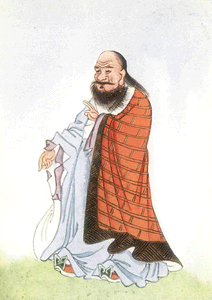
Five thousand years ago, and earlier, throughout all cultures, shamans blazed the spiritual paths. In India the shamanic traditions evolved into the yogic practices and philosophies we have been investigating. But this evolution was not confined to the valleys of the Indus, Saraswati (now gone), and Ganges rivers. In Europe (mostly in Greece), the Middle East, and in China, the same discoveries were being made. Over centuries, despite the distances and difficulty of travel, knowledge filtered out and was shared among the cultures. It is not surprising that we find similar concepts being discussed in the spiritual practices and philosophies of each region. However, the models and metaphors were modified to fit the local cultural landscape.
The concept of spirit (breath) in the European world had its counterpart in prana (breath) in India. In China the same energy was known as Chi. Chi is just one of several concepts central to Chinese medical practices. These concepts evolved out of native spiritual practices grouped together under the name Daoism. [1]
There are many forms of Daoism and many ways to practice the teachings. The Dao is sometimes personalized as a god, but most often it is impersonalized as a benevolent but disinterested power: the way of the universe. Live in harmony with the way and you will benefit. Struggle against the way things are and you will suffer.
Most Westerners know of the Dao only through the book by Lao-tzu called the Dao De Ching: the Way of Virtue. [2] In the Dao De Ching we learn that the Dao is the source of everything. It is nameless because whenever you try to capture the essence of the universe in a concept, you miss the totality of what you are trying to name. The Dao is infinite and inexhaustible. Only the Dao is unchanging and unchangeable.
Since everything is part of the Dao, it follows that the earth, sky, rivers, mountains, stars, and humans are also part of the Dao. Man is not outside of all this, man is a part of all this. In the Dao De Ching the message is: Get involved! Help, but help in a non-intrusive way. When finished, retire. Yang is acting. Yin is retiring. The Dao is the balance between the two.

In the Daoism of Lao-tzu, the sage is one who cultivates life. The sage learns physical techniques to do this: he regulates his breath, he hones his body, he garners health, and he manages his internal energies including the important sexual energy. Along with the physical techniques, the sage also follows ethical principles and regulates his own mind through meditation. Diet is also an important part of building and maintaining health. Through all these practices, the sage seeks to change his body and mind to recover youth and vitality and live in peace.
There are actually five main systems in Daoism. Let’s look at each one briefly.
- — Daoism is often spelled “Taoism” but since it is pronounced more with a “D” than a “T” we are adopting the former spelling.
- — Dao is the way; de means “virtue”, however, it is often translated as power; Ching is a book or story.
(Next: The Five Major Systems )
